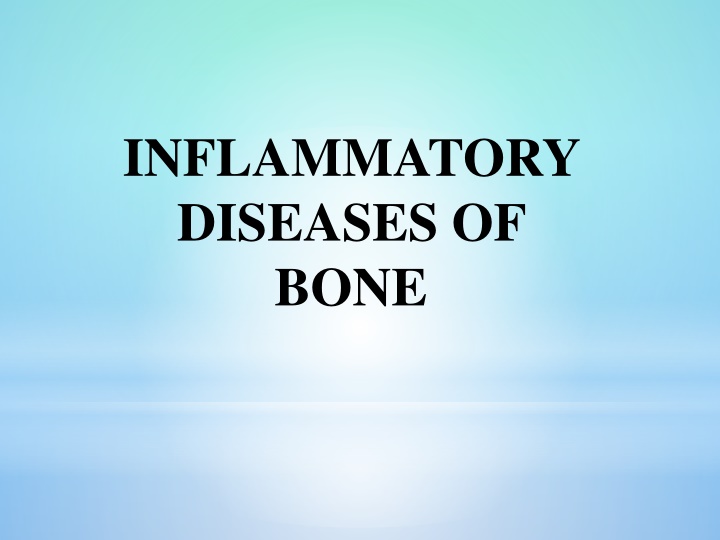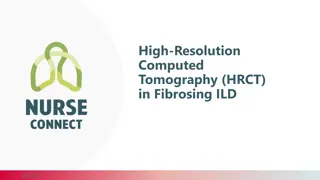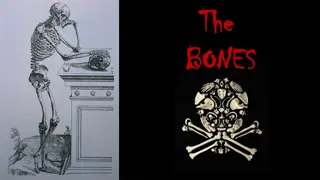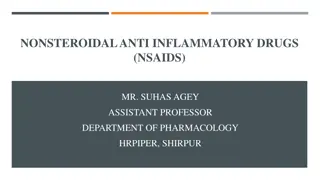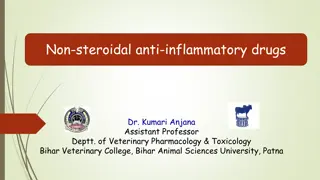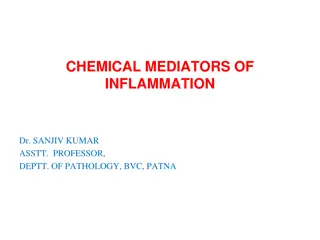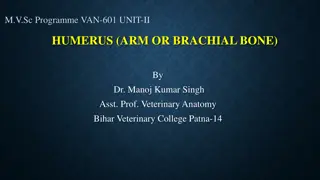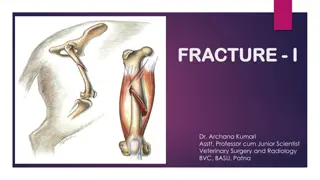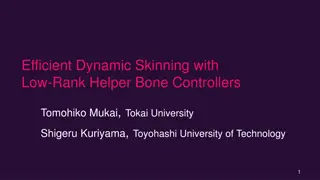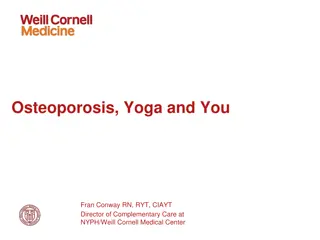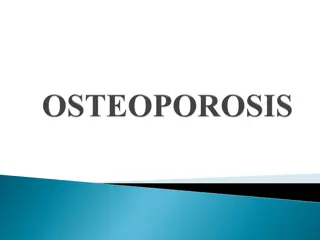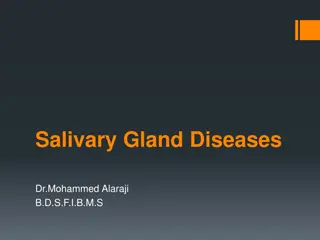Overview of Inflammatory Diseases of Bone
Inflammatory diseases of bone encompass conditions like osteitis, osteomyelitis, periostitis, and alveolar osteitis (dry socket). Osteitis is localized and may be associated with infected sockets, while osteomyelitis involves the interior of the bone. Alveolar osteitis commonly follows tooth extractions, particularly molars, and is characterized by a lack of blood clot formation. In cases where adequate clotting doesn't occur, bone infection and necrosis can result. Clinically, dry socket presents as severe pain, foul-smelling debris, and denuded bone. Osteomyelitis, once prevalent, is now rare due to antibiotics, with subtypes including suppurative and chronic forms.
Download Presentation

Please find below an Image/Link to download the presentation.
The content on the website is provided AS IS for your information and personal use only. It may not be sold, licensed, or shared on other websites without obtaining consent from the author.If you encounter any issues during the download, it is possible that the publisher has removed the file from their server.
You are allowed to download the files provided on this website for personal or commercial use, subject to the condition that they are used lawfully. All files are the property of their respective owners.
The content on the website is provided AS IS for your information and personal use only. It may not be sold, licensed, or shared on other websites without obtaining consent from the author.
E N D
Presentation Transcript
INFLAMMATORY DISEASES OF BONE
Osteitis is a localized inflammation of bone with no progression through the marrow spaces. particularly that associated with infected sockets. Osteomyelitis is inflammation of the interior of the bone involving and typically spreading through the marrow spaces. Periostitis inflammation of the periosteal surface of the bone and may or may not be associated with osteomyelitis. a more extensive
Alveolar osteitis (dry socket ) It occurs most commonly following the extraction of a molar. particularly a lower molar. The incidence then decreasing when premolar and incisor teeth are extracted. It also occurs with difficult extractions. The highest incidence of dry socket follow the extraction of impacted lower third molars. Tobacco use also been identified as a risk factor.
A dry socket is a localized inflammation of the bone following either the failure of a blood clot to form in the socket or the premature loss or disintegration of clot. This is due to a relatively poor blood supply of bone or following radiotherapy or it might result from the vasoconstrictors in anesthetics. excessive use of
In cases where an adequate blood clot forms, the latter may be washed away by excessive mouth rinsing or may disintegrate prematurely due to fibrinolysis most likely as a result of infection by proteolytic bacteria. The bone becomes infected and necrotic. Healing is slow and follows the proliferation of granulation tissue from the surrounding vital bone.
Clinically A dry socket is associated with severe pain developing a few days after extraction. The socket often contains foul tasting and smelling decomposing debris which can be washed away to reveal the denuded bone lining the cavity.
Osteomyelitis Although osteomyelitis of the jaws was a common complication of dental sepsis before the advent of antibiotics, it is now a rare disease. Various clinical subtypes were recognized: 1. suppurative osteomyelitis 2.Chronic sclerosing osteomyelitis 3.Osteoradionecrosis
Suppurative clinically into acute and chronic depending on the severity of symptoms and on the course of the disease. Disease persisting for longer than a month is usually referred to as chronic suppurative osteomyelitis. The source of the infection is usually an adjacent focus of infection or with local trauma (fractures, penetrating wounds and extractions). usually a polymicrobial infection. osteomyelitis: is divided
Anaerobic organisms and members of the 'black pigmented predominate. The mandible with its main blood supply is much more frequently involved than the maxilla because the vascular supply is readily compromised. Thrombosis of the mandibular artery or of its branching loops can lead to extensive necrosis of bone. In contrast, there is a rich supply in the mid-face area and osteomyelitis of the maxilla is rare. bacteroides group
Pathology of infection Following entry into the bone the organisms proliferate in the marrow spaces giving rising to an acute inflammatory reaction. The suppurative inflammation tends to spread through the adjacent marrow spaces and may extend through the cortical bone to involve the periosteum. Stripping of the periosteum, compromises the blood supply to the cortical plate and predisposes to further bone necrosis Eventually a mass of necrotic bone.
Radiographic: normal in the early stages, but after 10-14 days sufficient bone resorption may have occurred to produce irregular, moth- eaten areas of radiolucency. Clinically presents with pain , swelling ,pyrexia and malaise. Trismus is frequent and there may be paraesthesia of lip and mobility of teeth if they are involved.
In contrast to adults, infantile osteomyelitis characteristically involves maxilla. but this is now a rare disease. It is also referred to as neonatal maxillitis. but may present any time up to about nine months of age, and probably result from infection introduced during delivery or feeding. Staphylococcus aureus is the most common cause.
Sclerosing osteomyelitis : A. FOCAL Sclerosing osteomyelitis B. DEFUSE Sclerosing osteomyelitis C.Chronic osteomyelitis with proliferative periostitis (Garre's osteomyelitis, periostitis ossificans )
Chronic sclerosing osteomyelitis Localized lesions are identical to focal sclerosing osteitis and some previously reported diffuse types are probably examples of infected florid cemento-osseous dysplasia. However, diffuse sclerosing lesions of the mandible have occasionally been reported as a complication of spread from a contiguous focus of low-grade infection/inflammation such as a periapical granuloma
A.Focal Sclerosing osteomyelitis: Result from local response to mild infection or from high tissue resistance to infection. mainly around the apex of lower six and the condition is asymptomatic. Histology: increase in numbers and thickness of bone trabeculae and chronic inflammatory cells with fibrous tissue may be seen within bone marrow. Radiograph: radioopaque mass of sclerotic bone surrounding the apex of the tooth .
B. Defuse Sclerosing osteomyelitis Similar to focal type except it is more generalized through the mandible mainly in old persons. Acute exacerbation with suppuration and discharge may occur. Clinically : vague pain and discomfort. The mandibule may be enlarge due to subperiostial bone formation . Radiograph: Defused areas of radioopacities with radiolucent zones.
C. ossificans ) : is seen almost exclusively in the mandible in children and young adults, it is essentially a periosteal osteosclerosis presenting clinically as a bony hard swelling on the outer surface of the mandible. Result from the spread of low-grade chronic apical inflammation through the cortical bone. Stimulating proliferative reaction of the periosteum. Garre's osteomyelitis, periostitis
Occlusal radiographs Show a focal subperiosteal overgrowth of bone with a smooth surface (skin onion). Occasionally may develop from overlying soft-tissue infection or from the mechanical irritation of a denture.
Radiation injury and osteoradionecrosis Radiation as part of the therapy of oral malignancy affects the vascularity of the bone. This can have serious consequences in the mandible. The non-vital bone which results from the reduction in blood supply is sterile and asymptomatic but is very susceptible to infection and to trauma from a denture.
Infection may spread rapidly through the irradiated bone resulting in extensive osteomyelitis and painful necrosis of the bone often associated with sloughing of the overlying oral and occasionally facial soft tissues.
